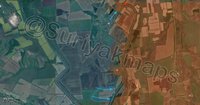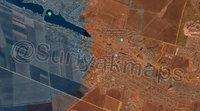Војна во Украина (исклучиво воена перспектива)
- Креатор на темата Vanlok
- Време на започнување
- Член од
- 17 август 2011
- Мислења
- 10.257
- Поени од реакции
- 18.205
Мислам не разбирате што пробува да ви каже. Пробува да ви објасни што е тероризам по дефиниција, ама good luck дека ќе го разбере тоа некој на темаваАма затоа им оди од корист кога ги гранатираа тие пограничните селца кај Белгород, па потоа градот, и тоа цивилни згради, па имаше и жртви.
Па диверзантски акции во тоа селцата кога убиваа баби и дедовци...
Или кога го напаѓаа мостот Керч.
Напади со дронови во Москва, не на воени цели итн. итн.
Се со цел да предизвикаат паника кај населението и да ја претстават Русија како порозна при одбраната на своите жители.
Среќа па во последно време намалија, изгледа ги повлекоа за уши.
- Член од
- 20 септември 2022
- Мислења
- 1.874
- Поени од реакции
- 7.138
Нема ништо од овој аеродром сега.Неверојатно е како се борат против окупаторот, за неколку денови околу 3 километри ослободени под артилериски оган.
- Член од
- 29 јуни 2014
- Мислења
- 25.663
- Поени од реакции
- 42.233
Вешеград е познат по прецизноста на нивните информации. Препорачлив медиум за луѓе што веруваат во делузии.
Vanlok
deus ex machina
- Член од
- 30 мај 2009
- Мислења
- 25.707
- Поени од реакции
- 33.934
Мислам не разбирате што пробува да ви каже. Пробува да ви објасни што е тероризам по дефиниција, ама good luck дека ќе го разбере тоа некој на темава
Терористички напади во светот
Да да дефинитивно, или да се намалат коњските сили на моторите, на пример над 70 коња да нема кола за да не може да развие голема брзина. Ако не па сите електрични тротинети да возиме :icon_lol:
forum.kajgana.com
- Член од
- 14 ноември 2013
- Мислења
- 7.169
- Поени од реакции
- 22.750
Situation south of Bakhmut: Ukrainian Army increased its gains around the railway southwest of Andriivka. In addition, clashes are taking place in the northern part of Klishchiivka where Russian Army is slowly withdrawing from the town.

Situation north of Donetsk: During the last days Ukrainian Army advanced south and recaptured a series of positions adjacent to the town of Opytne.

Situation west of Donetsk: During this week Russian Army managed to advance again in the town of Marinka along the streets of Naberezhna, Kashtanova, Shakhtarska and Polihrafichna. Clashes have reached the lake area, but it's not confirmed that Russian forces have consolidate its positions around it. As it was mentioned some days ago, there is a big grey area between both sides in which Ukrainian Army only controls now 20% of the town.


Situation north of Donetsk: During the last days Ukrainian Army advanced south and recaptured a series of positions adjacent to the town of Opytne.

Situation west of Donetsk: During this week Russian Army managed to advance again in the town of Marinka along the streets of Naberezhna, Kashtanova, Shakhtarska and Polihrafichna. Clashes have reached the lake area, but it's not confirmed that Russian forces have consolidate its positions around it. As it was mentioned some days ago, there is a big grey area between both sides in which Ukrainian Army only controls now 20% of the town.

The xx
Russia state-affiliated bot. ☑️
- Член од
- 8 април 2013
- Мислења
- 6.873
- Поени од реакции
- 12.977
Затвори вратата за нас неразбраните кога ќе излезеш.Мислам не разбирате што пробува да ви каже. Пробува да ви објасни што е тероризам по дефиниција, ама good luck дека ќе го разбере тоа некој на темава
Последно уредено:
Vanlok
deus ex machina
- Член од
- 30 мај 2009
- Мислења
- 25.707
- Поени од реакции
- 33.934
Maлку позадина за ова:Брутално! Руски спецназ со диверзантски акции во украинската позадина. Строго 21+
https://lostarmour.info/news/rabotaet-sso
Vanlok
deus ex machina
- Член од
- 30 мај 2009
- Мислења
- 25.707
- Поени од реакции
- 33.934
The Sword of Damocles - the Russian Army's force buildup through 2023 and what it means for the Ukrainian War going forward.
One of the biggest - and certainly the most consequential - question marks in the world right now is the current status of the Russian Army. Some particularly dim Western commentators and even senior officials have claimed recently that the Russians have lost half or more of their combat power from the date of their initial invasion in February 2022 and are now weaker than the Ukrainians overall. These claims have so many problems they're barely worth discussing and should simply be dismissed out of hand. Let's work through a real analysis instead.
Claims the Russians had a "million-man army" prewar are simply false - that was the total number of people in the entire Russian Armed Forces. The Russian "Army" (between the Army proper, the Naval Infantry, and the VDV) was only some 350,000 personnel, of whom approximately 100,000 were conscripts. This manning level supported some 183 combined-arms battalion task forces under the now-deprecated Battalion Tactical Group organizational scheme. In real terms this meant that for every 1900 soldiers in the overall force the Russians would get one maneuver battalion with appropriate supporting arms.
This can be immediately sanity-checked by comparison to the United States Army. In 2018 the active-duty US Army had 31 Brigade Combat Teams, each of which had four maneuver* battalions for a total of 124 appropriately-supported battalions on an end strength of 483,500. When accounting for the fact that Russian units are about 2/3 the size of their Western counterparts (31 versus 44 tanks in a battalion, for instance), this means that the two armies had close to exactly the same number of effective battalion task forces available and the Russians are about 30% more efficient at converting end strength to combat power. This is to be expected given Russia's relative lack of logistical, administrative and command overhead without global commitments.
* I am including the BCT's organic cavalry squadron as a maneuver battalion because it is frequently tasked as such operationally and has the capability to perform maneuver tasks.
Now to the war. The Russians began recruiting volunteers quite early in the war, but more significant in the early stages of the war was industrial mobilization. As early as March 2022 Russian military industry began hiring huge numbers of personnel and ramping up production of war materiel across the board. Part of this was to replace equipment lost in combat but much of it was, I now have reason to believe, the leading edge of a deliberate plan to build out the Russian Army in the coming months. Mobilization of personnel was to come later, first with small-scale recruitment of volunteers over the Spring and Summer of 2022 and then with formal mobilization in Fall 2022.
Russian mobilization came in two waves. First there was an announced increase in the Russian military's end strength of 137,000 in August 2022, exactly the number of conscripts then in service. This suggests strongly that the 2021-2022 conscript class was simply retained in service for the duration. The second wave was the "partial mobilization" of 300,000 in September 2022, which was subsequently converted into another increase in the Russian Army's authorized strength. This gives us a current strength of the Russian Army as some 750,000 soldiers, more than double its strength in February 2022 and - highly significantly - with 650,000 instead of 250,000 soldiers deployable as either "contract" or "mobilized" soldiers.
It should be noted that the Russian mobilization of last year was not a "one-time" callup - it was a permanent expansion of the size of their army to be filled with ongoing recruitment efforts, conscription, and mobilization of reservists. This is a force that is being continually filled and which can be expected to be at or near its authorized strength.
Applying our ratio from earlier (1900 troops to generate one battalion task force) we get a post-expansion Russian force of some 395 maneuver battalions with enablers. This is an enormous force that could easily secure Russia's borders (particularly its now very-hostile western borders) while simultaneously overwhelming the battered Ukrainian military. Should NATO intervene directly, this force would be able to slug it out with any Western expeditionary force that could be realistically deployed into theater.
But Armchair Warlord, you say, the Russians are running out of troops and tanks - all the Twitter blue checks are telling me this! What evidence do you have? Well, I have a few data points in support of my theory.
1. Russia recently withdrew from the Treaty on Conventional Forces in Europe. The CFE treaty, originally signed in 1990 and adapted in 1999 to post-Cold War realities, sought to place national ceilings on conventional arms stationed in Europe and at first served to place a cap on the amount of hardware the Warsaw Pact could flood across the North German Plain on short notice. Serious Russia observers have long noted that, far from his characterization in the West as an unhinged autocrat, Vladimir Putin is a boring neoliberal with a highly legalistic approach to governance. Although the Russians suspended their participation in the treaty in 2007, their recent denunciation is, I believe, highly significant.
Under the treaty the Russian Federation was allowed to station some 6,350 tanks, 11,280 APCs (including 7,030 IFVs) and 6,315 artillery pieces west of the Urals. A force of some 350 BTG-equivalents deployed west would consist of approximately 4,000 tanks and some 10,000 infantry carriers as well as 6,300 artillery pieces. This strongly suggests to me that the Russians denounced the treaty because some dimension of their force build, likely either artillery pieces or infantry carriers, violated its limitations.
This is, by the way, an enormous army and explains the "all of the above" approach the Russians have taken to procuring war materiel lately. They wouldn't be simultaneously rolling large numbers of T-90Ms and T-80BVMs off the assembly lines while also doing deep modernizations of their T-62 fleet for use as frontline tanks unless they had a real need for a genuinely enormous tank fleet in the near term. Same story with APCs and artillery.
2. Contrary to what certain pro-Western analysts and officials have asserted, the Russian side of the northeastern Ukrainian border (the "non-active" front line on the prewar border) is packed with troops. What immediately struck me during the abortive Ukrainian raids on Belgorod Oblast earlier this year was the size, speed and ferocity of the Russian counterattack, with multiple Russian battalions quickly mobilizing to throw back the attackers. Russian forces responding to the attacks were often apparently from different brigades or even divisions, with different equipment sets and distinct tactical signs, and they arrived and deployed for combat in large, intact units with fresh equipment.
This same region would be the simplest area for the Russians to concentrate forces in without disturbing logistical efforts for the "active" front line to the east and south, and a large offensive from this direction would quickly carve through the thin screen of Territorial Defense units covering the border, turn the main Ukrainian army deployed in the Donbass, and lead to a rapid collapse of the Ukrainian position east of the Dniper.
3. In June, the Russians announced the actual units they intend to create as a result of this force buildout. The new ground force units announced were one Combined Arms Army (a corps-sized formation), one new Army corps, five new divisions, and 26 new brigades. It is unclear whether these units are entirely separate or whether they are intended to nest within each other matryoshka-style, but this would either be 78 new BTG-equivalents (if the units above brigade level are just new headquarters) or a whopping 177, very much in line with my calculations above (if all of these are complete units).
We haven't seen this "doom army" yet because the Russians are still pursuing their Fabian strategy of letting the Ukrainians and their NATO sponsors beat themselves bloody against their defensive line in the Donbass. The Russians can now be expected to launch a large-scale offensive at a time, place, and in circumstances of their choosing - given the exhaustion of the AFU in its monthslong offensive the time for "big red arrows" is, I feel, ripening.
It should also be noted that the Russians do not seem to be leaving anything at all to chance. In Zaporozhe, for example, they constructed several defensive lines in a deep, complex scheme in preparation for an offensive they ended up stopping close to the line of contact. I would expect similar thoroughness out of their offensive preparations.

- Член од
- 29 јуни 2014
- Мислења
- 25.663
- Поени од реакции
- 42.233
Се збори за некаква голема офанзива, или ќе биде многу скоро или на зима ако воопшто ја има.
Vanlok
deus ex machina
- Член од
- 30 мај 2009
- Мислења
- 25.707
- Поени од реакции
- 33.934
Детално е миниран сегашниот активен фронт, другите реони веројатно не се толку сатурирани. И вообичаено мините сами по себе не се најголем проблем за напредување, не без луѓе/војници/техника позади минските полиња. А во врска тоа - како што погоре објаснуваат - Фабијановата стратегија веќе си го прави своето... Инаку и јас мислам дека нема да има голема руска офанзива наскоро, не до следната пролет.
The xx
Russia state-affiliated bot. ☑️
- Член од
- 8 април 2013
- Мислења
- 6.873
- Поени од реакции
- 12.977
Другото е енигмата кои структури ги спрема за офанзивни операции.
Пред конфликтот освен ВДВ и Вагнер, многу малце имаше единици кои се спремни да извршат офанзивни операции. Пред се армијата ма РФ и доктрината на СССР се основаат претежно за дефанзивни операции.

 simplicius76.substack.com
simplicius76.substack.com
Пред конфликтот освен ВДВ и Вагнер, многу малце имаше единици кои се спремни да извршат офанзивни операции. Пред се армијата ма РФ и доктрината на СССР се основаат претежно за дефанзивни операции.

Myths and Realities of the Russian/NATO NCO Systems
A few days ago Russian war correspondent Sladkov made an interesting post where he showcased two new videos from Western/pro-Ukrainian military experts that go into detail in describing Russian tactics and military strengths in the Ukrainian conflict.
